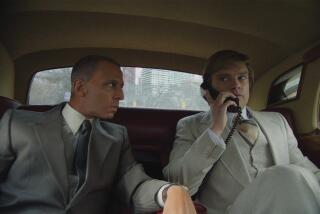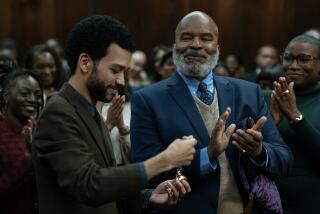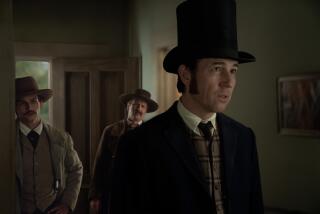As a 1960s NASA chief, Kevin Costner fights racism and reaches the stars in ‘Hidden Figures’
Considering he once made a movie about the meaninglessness of a tin cup of the sort a scuffling second-tier golf pro might win on the circuit, it’s perhaps not such an odd artifact that Kevin Costner kept once he’d completed work on the heart-stirring chunk of ‘60s racial history “Hidden Figures.” The one souvenir he took home with him after the shoot was a humble prop coffee pot.
In a curious way, that hunk of aging aluminum figures large in the story told by Ted Melfi (“St. Vincent”), who co-wrote and directs.
The film (which will see limited December release before going wider in January) centers on three female African American NASA employees, all small-town Virginia math wizards, who are seen early on driving to their jobs at the space agency in 1961. There they perform invaluable (if initially undervalued, due to the casual racism of the time) computations in service of the nation’s space race with Russia. The key saga belongs to Taraji P. Henson’s character, Katherine Johnson, a mix of awkward charm and steely resolve.

A trailer for “Hidden Figures,” starring Taraji P. Henson and Octavia Spencer.
Costner is their boss, Al Harrison, director of the project and a lead engineer at the Langley facility. Hounded by Washington bureaucrats and his own patriotic fervor, he’s in search of “a single person, in this entire building, that can handle Analytic Geometry.”
What Al fervently wants to know, says Costner, is “What has kept us back, kept us from working together? Al tries to infuse a level of leadership, of teamwork.”
The deftest part of the script Melfi wrote with Allison Schroeder from a nonfiction book by Margot Shetterly is to show how Harrison, his No. 2 Paul Stafford (an initially spiky martinet nicely played by Jim Parsons) and the entire agency come to realize that their own prejudices were blocking progress.
As both a long-tenured movie star and a socially conscious filmmaker who put his own money in 2014’s “Black or White” and scored admiring reviews for his role as a marginally racist character, Costner was a logical go-to, and he quickly warmed to the script.
Except for, well, his part.
“The real story,” says Costner, “is that Al is the character I liked least when I read it.” This was early in 2016 with the film racing toward production. “So this was a real moment of reckoning — what am I going to say to this guy, because there’s really not a lot of time for us.
“I told him that I thought the women were written just right, everybody loves this movie, but I don’t think the Harrison part stands up. It doesn’t feel complete.” Melfi knew Costner wasn’t looking for a bigger role or more lines. “I knew it was about the girls,” says Costner of the film, “and that was OK.”
Says Melfi, “The first day I met him at his house and we went through the script, I realized that this is the ultimate filmmaker. He literally only cares about the entire story having a heart, and finding the beats that make the story effective.” Melfi had unsuccessfully sought to get the life rights from certain NASA ex-directors for the script, he told Costner.
“And then he said to me he didn’t devote the same time to that character,” adds Costner, “because when he couldn’t get the rights, he combined three guys. I said, it reads like three guys.”
With neither the time nor inclination to fully reconfigure the Harrison part, Costner took on the physical prep, getting Melfi to sign off on a flat-top haircut, and looking to the style, fit and color of period-apt Brooks Brothers suits. He added a chewing gum habit, and a certain remoteness, and then asked to recede from, rather than dominate, certain scenes — as when Stafford interrogates Johnson over a security breach. Each day before Costner would shoot a scene, he’d come to the set and block it out for himself, running his lines all the while.
For some of these scenes that were big and meandering,” says Costner, “I’d find the movements, maybe ask for a trash can or coat rack on the set, ask if instead of the big room could we be in the smaller room. Ted was such a great partner; he trusted me.”
Parsons says of his shared scenes, “I found Kevin absolutely mesmerizing in his part — the still, concentrated, honesty he has. He comes to the set having put so much work in, and it’s inspiring and also a relief, because you realize it’s not some sort of magic potion — he’s a craftsman and he loves doing the work.”
For the scene in which Henson’s math genius finally explodes in the face of unremitting bias, Costner was charged with lighting her fuse, spurring a great speech — “She was ready for that and she went for it,” he says — and then his own. Harrison ends up in a hallway angrily knocking down an offensively racist sign. But first, more subtly, he finally awakens to the entire injustice, epitomized by a label reading “colored” on the coffeepot Johnson’s been provided so she won’t use her white male colleagues’ coffee.
“Originally, that coffeepot sticker wasn’t in the script,” says Melfi, “then Kevin said, ‘I really feel like I should do something before I knock that sign down — a smaller step.’ We came up with this idea to take that label off, and he just did it with such class, as Al is thinking, ‘Something around here is not right, and I now understand it.’ That scene is so touching to me, because aside from the pain and anger and frustration that Taraji unleashes in that moment, the compassion on Kevin’s face when he finally gets it is for me when the tears come. You go, that’s a man who just realized the impact of segregation on a person’s life.”
“What I found in Al there,” agrees Costner, “was about a level of disappointment even in myself — that I never even looked over there and saw that? How could I have missed that? If you take the politics out of everything, it makes it so much simpler. And you can lose that when you overthink it, because movies are at heart not an intellectual experience — they’re an emotional experience.”
See the most read stories this hour »
More to Read
From the Oscars to the Emmys.
Get the Envelope newsletter for exclusive awards season coverage, behind-the-scenes stories from the Envelope podcast and columnist Glenn Whipp’s must-read analysis.
You may occasionally receive promotional content from the Los Angeles Times.







